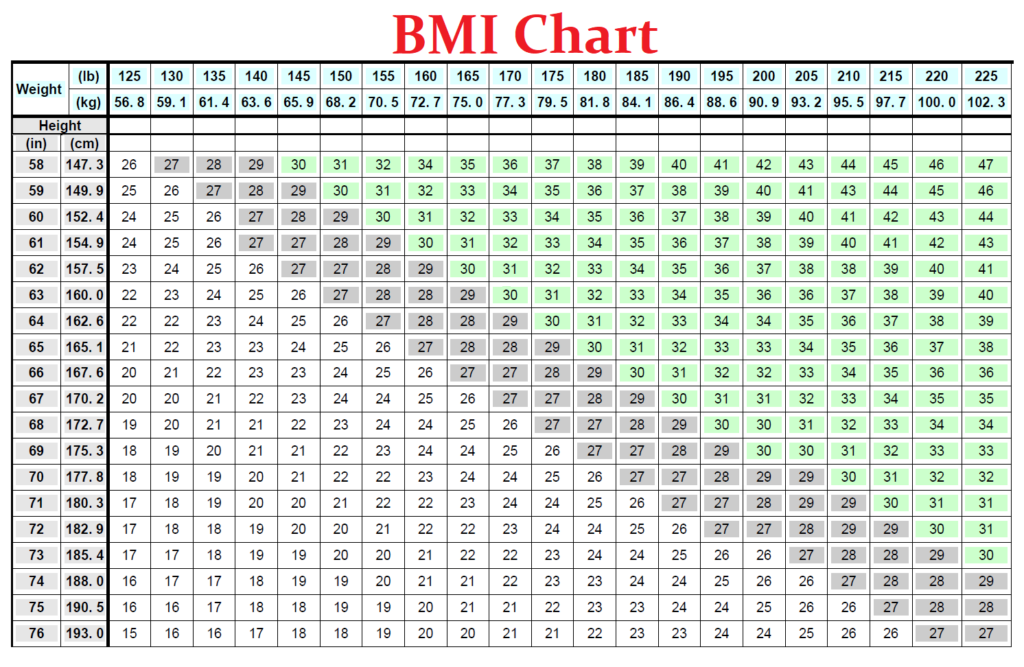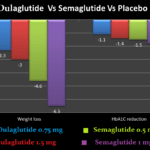BMI or Body Mass Index was previously known as Quetelet Index. This is essentially a method used to calculate a person’s nutritional status.
Two components are required for this calculation:
- a person’s height in meters, and
- weight in Kilograms.
By definition, BMI is the calculation derived by the division of an individual’s body mass (in kilograms) by the square of his/her height (in meters). It aids in screening for any weight-related health problems.
BMI Formula:
The formula provided for Body Mass Index is as below:
Body Mass Index = weight (in kilograms) / height (meter)2
A person with a height of 165 cm (5 feet and 6 inches or 1.65 meters) and a weight of 60 kg has a BMI of 60/ (1.65)² = 22.04
History of BMI:
This measuring formula was developed by “Lambert Adolphe Jacques Quetelet”, who was a Belgian astronomer, back in the 19th century (1830-1850).
In the 1970s, scientists found out that the body mass index was useful as a substitute to measure and estimate problems associated with adiposity and excessive weight gain.
This helped in assessing what type of resources and where they were to be allocated in a given population to reduce the risk of diseases linked with excessive or insufficient weight gain.
Uses of BMI in clinical practice and diabesity clinics:
This is currently the most effective anthropometric tool available which can measure the level of obesity or emaciation.
BMI has been used in many clinical practices as a source of estimating and evaluating the level of adiposity in a person according to their lifestyle.
Another useful application of this method is that it can analyze whether a person’s height is precise in relation to their weight.
The use of BMI allows physicians to assess the health status of their patients according to their nutritional status or any other medical disorder.
In this way, they can take measures to correct the related problems either by giving a proper diet chart or required medications.
At the moment, obesity is a serious concern, especially during the COVID-19 pandemic. People’s lifestyles have become sedentary and physically inactive because of the shift of business or education systems towards the internet. This has led many people to gain weight as they are not as active as they used to be.
In order to combat such weight-related issues, BMI is used as a primary tool to examine the extent of adiposity. It is much easier to use and is a pretty inexpensive method too because it requires only height and weight for measurement.
The use of BMI does no harm to the body and it is a non-invasive tool which is why this is most commonly used in clinical practices. Even though the test characteristics of BMI are less specific but they are still acceptable.
Body Mass Index Charts:

You can use the BMI charts available to examine your own BMI. There is a set of ranges that tell you whether you fall in the overweight, underweight, obese, or super obese category.
BMI has different calculations for adults and children or teens.
BMI ranges for adults:
BMI | Weight status |
| Less than 18.5 | Underweight |
| Between 18.5 and 24.9 | Healthy weight |
| Between 25.0 and 29.9 | Overweight |
| 30.0 or above | Obese |
What are Morbid Obesity and Super Obesity?
Morbid Obese and Super obese are two other terms nowadays being commonly used to label people who have extreme obesity.
Morbid obesity is defined as a BMI of 40 kg/m² or more. For Asians, a BMI of 35 kg/m² or more is labeled as Morbid Obesity.
Super Obesity is defined as a BMI of 50 kg/m² or more. The cut-off of super obesity has not been clearly defined for Asians, however, most people label an Asian person with a BMI of 40 kg/m² or more as super obese.
What are the different classes of obesity?

Obesity is defined as a BMI of 30 kg/m² or more. It is frequently subcategorized as:
- Class 1 Obesity: BMI of 30 to <35 kg/m²
- Class 2 Obesity: BMI of 35 to <40 kg/m²
- Class 3 Obesity: BMI of 40 kg/m² or more
Class 3 obesity is usually labeled as severe obesity.
Body Mass Indices for children and teens:
For teens and children, the body mass index is demonstrated as a percentile after it has been calculated. That percentile is derived from either a percentile calculator or a percentile graph.
Such percentile growth charts of Body Mass Index-for-age are typically used to assess their weight status.
The categories for this BMI-for-age percentiles are given below. These ranges are provided by the CDC. [Ref]
Weight status | Range of percentiles |
| Underweight | Below 5th percentile |
| Healthy weight | From the 5th to less than the 85th percentile |
| Overweight | 85th to below 95th percentile |
| Obese | Equal to the 95th percentile or greater than that |
Why is BMI different for adults and children, and teens?
The method or formula used to calculate the body mass index for adults and children or teens is similar. But it is interpreted in different ways.
The BMI ranges among teens and children are demonstrated in relation to other children and teens of the same gender and age. With the help of CDC growth charts, these percentiles are evaluated.
Obesity is marked at the 95th percentile or above on these charts for children. So, for a girl who is 10 years old and has a body mass index of 22.9 kg/m2, this would place her at the 95th percentile and declare her an obese kid.
These body mass index-for-age growth charts are available on the CDC’s website. [Ref]
Limitations of BMI (Body mass index):
The use of body mass index is very common, but it has some limitations that prevent it from being almost perfect.
It is not recommended to completely depend on the body mass index as a method to estimate the extent of body fat deposition because in some individuals it tends to overestimate adiposity, and in some, e.g., in athletes and it can underestimate it in others, e.g., people with insufficient lean body mass.
Similarly, it does not differentiate between lean body mass (LBM) and fat mass. Therefore, some individuals may have an increased level of muscle mas,s but they still may have a high body mass index.
Since it is not a direct indicator of adiposity in both adults and children, BMI is not preferred for use as a diagnostic tool. Instead, it is favorably used as a screening tool in order to assess the weight status of a given population.
During the previous few decades, the standards of body mass index have considerably varied because it is not clear where we can set the overweight and obese thresholds on a BMI scale.
BMI Alternative Formulas and Tools:
Since the use of BMI is limited, despite it being a convenient tool. There are some alternative methods that can be utilized.
Waist Circumference:
Waist Circumference is an old-fashioned way to measure adiposity using a measuring tape. It is a good indicator of the amount of abdominal fat you have. A normal value of waist circumference for women is 35 inches, and for men, it is 40 inches.
Waist to Hip Ratio:
The waist-to-hip ratio is another method that you can use to estimate the extra fat that you might have.
Body Adiposity Index:
Body Adiposity Index is another alternative to BMI, and unlike BMI, this only requires your hip circumference and height.
Although there is not enough evidence as to how accurate this is, it is widely accepted as a more accurate method than BMI.
In Summary:
BMI (Body Mass Index) is a simple formula-derived tool that is used to categorize people into different weight and obesity groups.
BMI is commonly used to assess the efficacy of weight-loss medicines and bariatric surgeries.
Sample BMI Table Chart for different heights:
Height | Body Weight | BMI Category |
| 5’ 6”(5 feet, 6 inches, or 165 cm) | Less than 50.4 Kg | Underweight |
| 50.5 kgs to 67.8 kg | Normal Weight | |
| 67.9 kgs to 81.40 kg | Over Weight | |
| 81.5 kgs to 108.9 kg | Obese | |
| 109 kgs to 136 kgs | Morbid Obese | |
| 136.1 kgs and above | Super Obese | |
| 5’ 9”(5 feet, 9 inches, or 172.5 cm) | Less than 55 Kg | Underweight |
| 55.1 kgs to 74 kg | Normal Weight | |
| 74.1 kgs to 89 kg | Over Weight | |
| 89.1 kgs to 119 kg | Obese | |
| 119 kgs to 148.8 kg | Morbid Obese | |
| 148.9 kgs and above | Super Obese | |
6’(6 feet or 180 cm) | Less than 59.9 Kg | Underweight |
| 60 kgs to 80.7 kgs | Normal Weight | |
| 80.8 kgs to 97.2 kgs | Over Weight | |
| 97.3 kgs to 129.6 kg | Obese | |
| 129.7 kgs to 162 kg | Morbid Obese | |
| 162.1 kgs and above | Super Obese |
- 97% Pure Berberine Powder – High-purity, plant-derived extract with a rich yellow color. Carefully processed and lab-tes…
- Naturally Bitter Taste – Berberine has a strong, naturally bitter flavor. Best enjoyed when mixed with smoothies, tea, c…
- 100g in Resealable Foil Pouch – Packaged in a premium aluminum pouch to protect from moisture and light, keeping the pow…

- 5 Delicious Flavors: Freeze-Dried Mango, Freeze-Dried Blueberry, Freeze-Dried Orange, Freeze-Dried Dragon Fruit & Freeze…
- Pure and Natural Ingredients: Our fruit powders are made without synthetic pesticides, GMOs, or harmful chemicals. Each …
- Health Benefits: Our carefully selected fruits are packed with antioxidants, vitamins, fiber, and digestive enzymes to s…

- 🌿 4 Tangy Citrus Flavors in One Pack: Enjoy a delicious variety of Orange, Lime, Lemon, and Kiwi powder – 5 sachets of e…
- 💧Easy to Mix & Refreshing: Just add to water, smoothies, sparkling drinks, or tea for a vibrant citrus kick. Dissolves i…
- 🛡️Rich in Vitamin C & Antioxidants: Made from real fruit powders, this mix offers a natural source of vitamin C to suppo…

- VARIETY PACK – Includes 5 delicious organic berry powder flavors: Freeze-Dried Goji Berry, Freeze-Dried Strawberry, Free…
- PURE INGREDIENTS – Made with 100% natural, freeze-dried berries and absolutely no added sugar, artificial ingredients, o…
- CONVENIENT PACKAGING – Contains 20 pre-portioned 5g packets (100g total), eliminating the need for measuring and ensurin…








